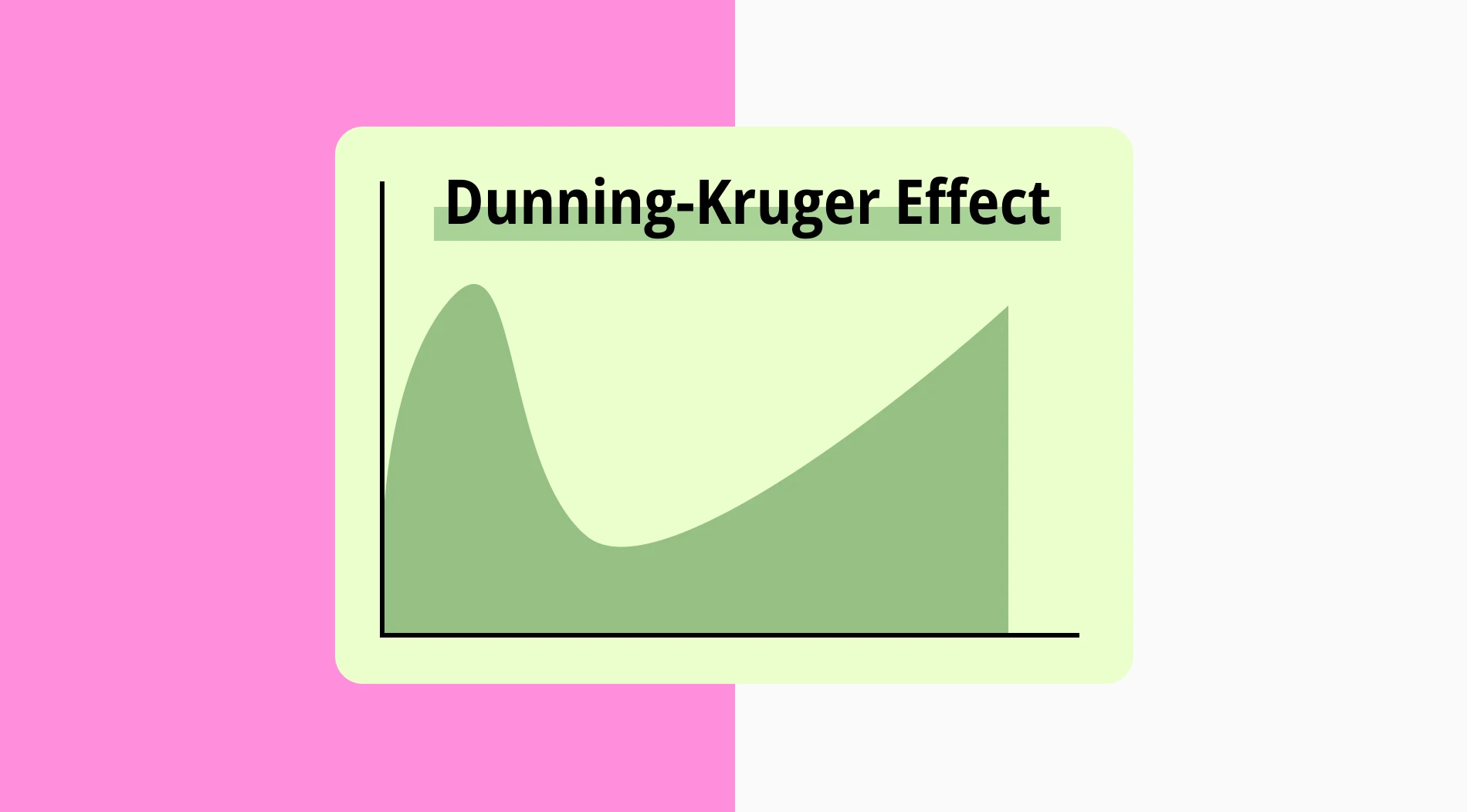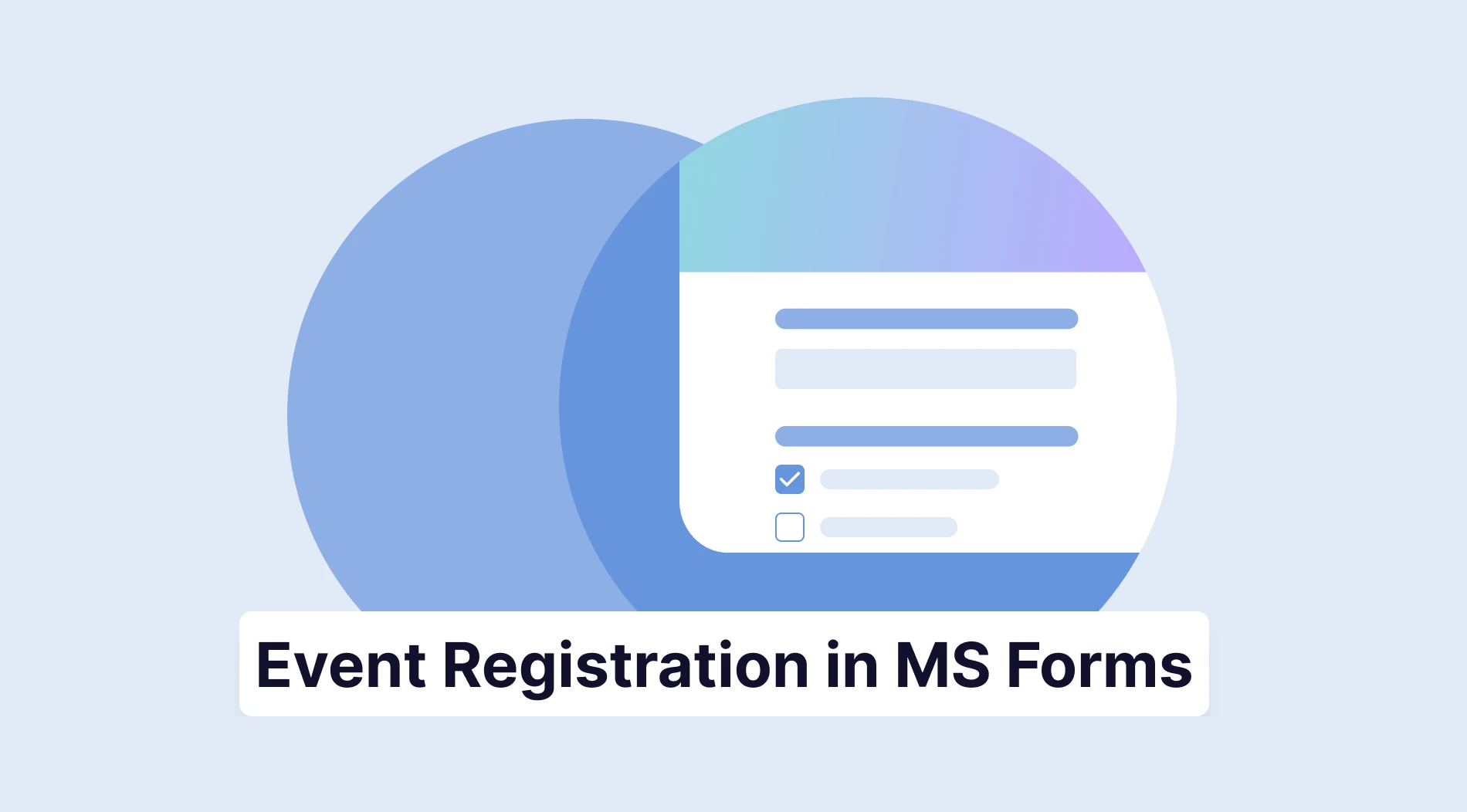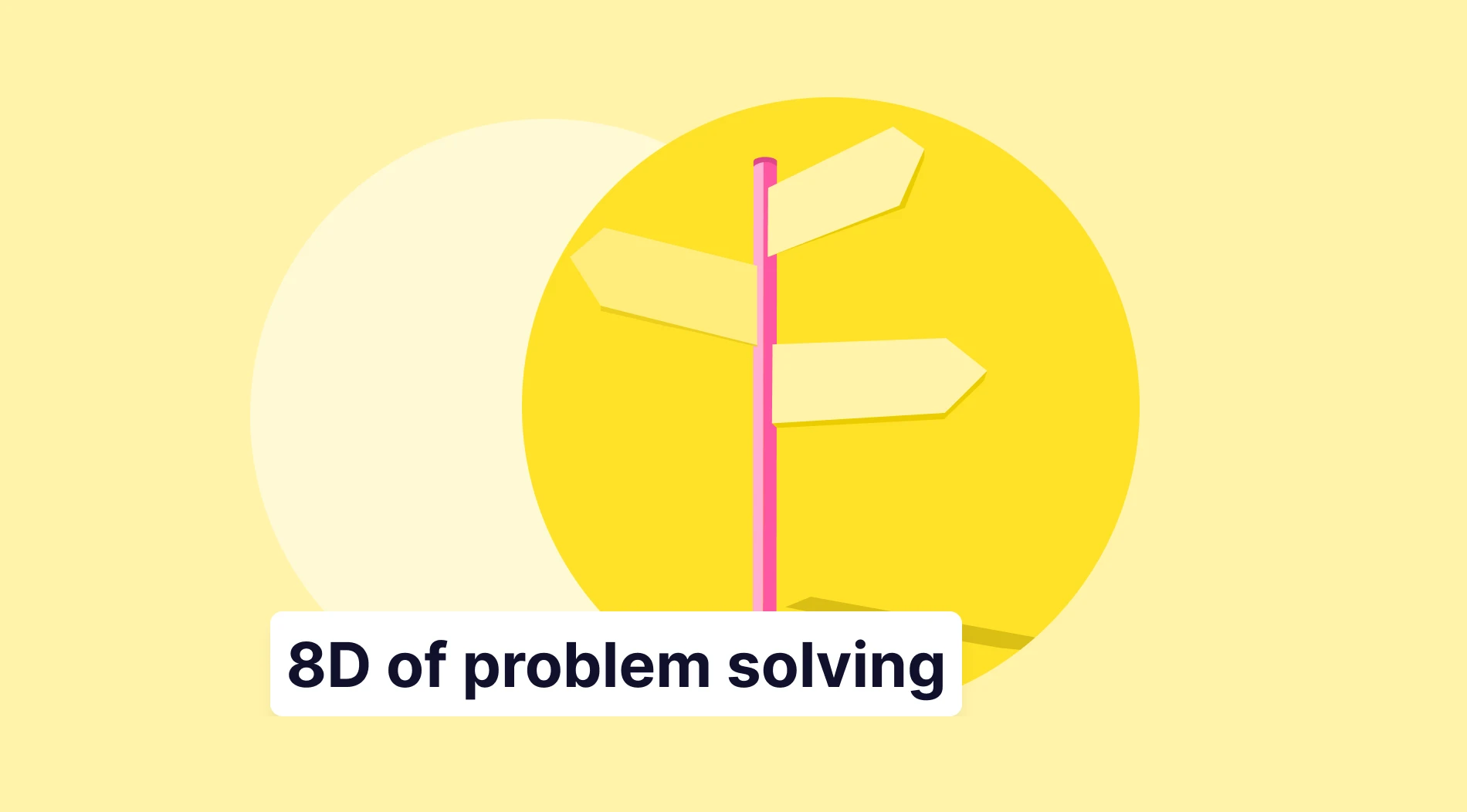Understanding cognitive models like the Dunning-Kruger Effect is crucial for personal and professional growth. These insights help identify overconfidence and knowledge gaps, leading to better decision-making and continuous improvement. Embrace these models to enhance self-awareness, foster development, and achieve greater success in your endeavors. Dive in to learn how these models can transform your life.
This article will cover the Dunning-Kruger Effect in detail. You will learn what it is, how it works, and see real-world examples of its impact. We will also discuss how to use this knowledge effectively and when to apply it in different scenarios. You will have a comprehensive understanding of the model.
Let’s start with the basics: What is the Dunning-Kruger effect?
The Dunning-Kruger Effect describes how people with low ability in a particular task tend to overestimate their competence.
The Dunning-Kruger Effect originates from the original paper of the psychologists David Dunning and Justin Kruger. This overconfidence occurs because they lack the skill to recognize their deficiencies. As a result, they misjudge their actual abilities, leading to poor decisions and inflated self-assessments (dual burden).
This effect also implies that highly skilled individuals may underestimate their competence. They assume that tasks which are easy for them are equally easy for others. This dual aspect of overestimation and underestimation explains many everyday misunderstandings and misjudgments. Recognizing the Dunning-Kruger Effect is vital for personal growth and accurate self-assessment.
What does trigger the Dunning-Kruger effect?
Now, we'll explore what may trigger the effect. Understanding these elements, such as cognitive bias and metacognitive deficit, etc. helps in recognizing and addressing this effect effectively.
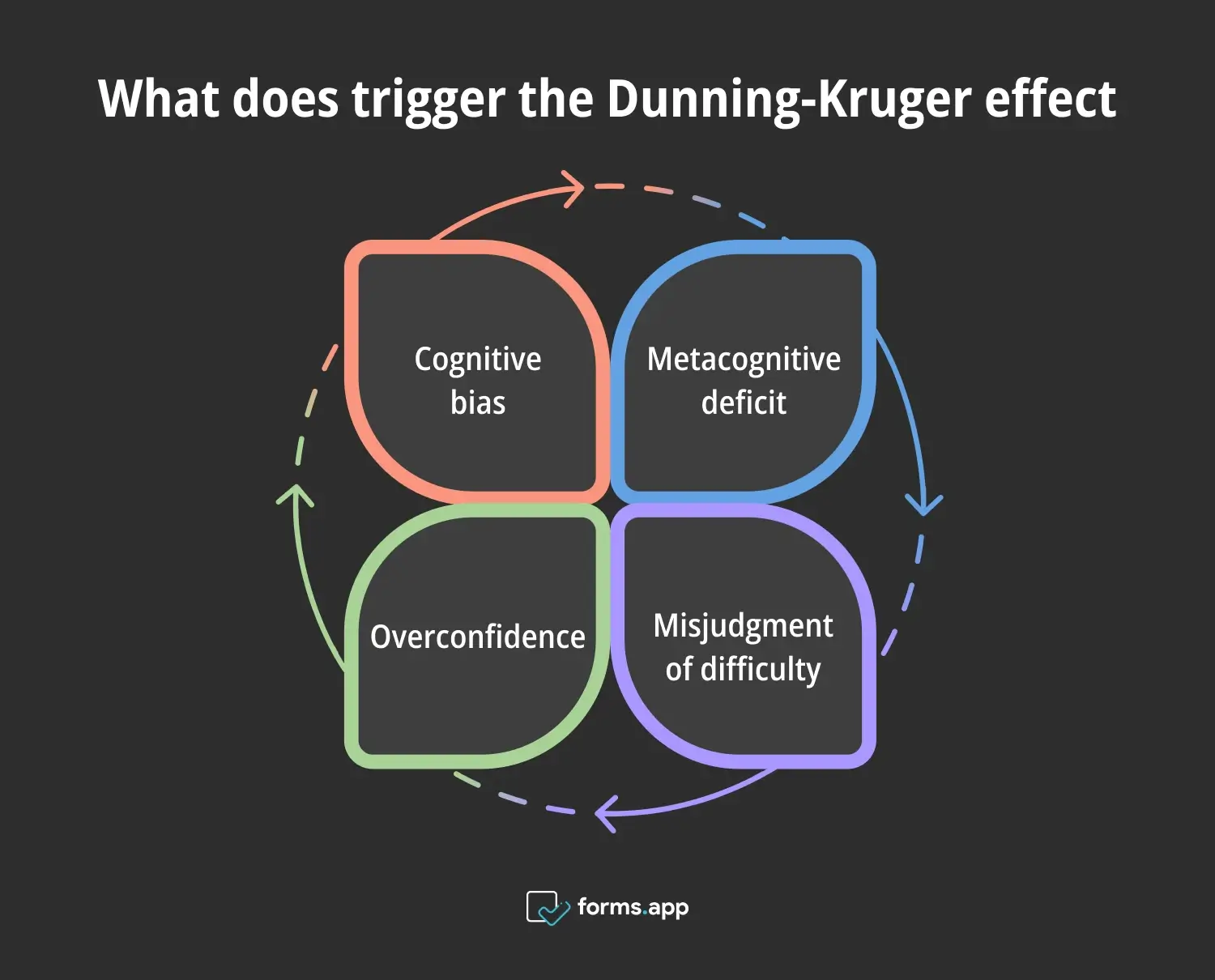
Aspects that trigger the Dunning-Kruger effect
a. Cognitive bias
The Dunning-Kruger effect arises from a cognitive bias where individuals with limited knowledge or skills tend to overestimate their competence. This bias leads them to believe they are more capable than they actually are. It influences their perceptions and decision-making processes. It stems from a lack of objective self-assessment, causing a cycle of overconfidence despite evidence suggesting otherwise.
b. Metacognitive deficit
A critical trigger is the lack of metacognitive ability necessary to accurately assess one's own abilities. Those affected by the Dunning-Kruger effect often lack the awareness to recognize their own incompetence. This deficit prevents them from adjusting their self-assessment based on feedback or performance outcomes. This leads to inflated self-perceptions that do not align with their actual capabilities.
c. Overconfidence
The Dunning-Kruger effect triggers overconfidence, where individuals believe they possess greater skills or knowledge than they actually do. This false sense of confidence can lead to errors in judgment and decision-making, impacting personal and professional outcomes.
Overconfident individuals may underestimate the complexity of tasks or dismiss feedback that contradicts their inflated self-assessments. This causes a cycle of misjudgment and poor performance.
d. Misjudgment of difficulty
Another trigger is the misjudgment of task difficulty. Individuals affected by the Dunning-Kruger may also be performers underestimated. The overconfident yet unaware manager may assume that the employees are not capable of certain tasks. This misjudgment exacerbates the overestimations of their own competence.
Lack of feedback
The absence or dismissal of feedback is a significant trigger for the Dunning-Kruger effect. Without constructive criticism or accurate performance evaluations, individuals cannot adjust their self-assessments. This lack of knowledge and external input causes inflated perceptions of competence. Because individuals continue to believe they are more capable than they are objective.
Social comparison
Social comparisons can also trigger an average effect. This happens when individuals compare themselves with others possessing lower skills or knowledge. In this context, individuals may develop a false sense of superiority. They may believe they are more competent than their peers.
How to address the Dunning-Kruger Effect
Addressing the Dunning-Kruger Effect begins with self-awareness and a commitment to honest evaluation. By understanding the factors below, Individuals can mitigate overconfidence and enhance their understanding of true competence levels. This proactive approach fosters personal growth and professional development.
🪞Self-reflection: Start by engaging in deep introspection to assess your skills and knowledge objectively. Reflect on past achievements and challenges, considering how they contribute to your overall competence. This process helps your ability to recognize the areas where you may be overestimating your abilities.
💬Seek feedback: Actively solicit feedback from peers, mentors, or supervisors who can provide constructive criticism. Listen attentively to their perspectives and insights without defensiveness. Their observations offer valuable external perspectives that can reveal blind spots or areas needing improvement.
⚖️Compare objectively: Benchmark your skills against industry standards or objective criteria. This allows for a realistic assessment of your capabilities within a broader context, preventing inflated self-assessment.
💡Commit to continuous learning: Embrace a mindset of lifelong learning and professional development. Pursue opportunities for training, workshops, or further education to expand your knowledge base and skill set continuously.
🕊️Cultivate humility: Foster humility by acknowledging that everyone has room for growth. Avoid dismissing feedback or assuming expertise beyond your current level of experience. Humility fosters openness to learning and improvement.
🔁Review and adjust regularly: Periodically revisit your self-assessment and goals. Reflect on new feedback, experiences, and achievements to refine your understanding of your abilities. Adjust your development strategies accordingly to maintain realistic self-awareness and mitigate the Dunning-Kruger Effect effectively.
Examples of the Dunning-Kruger effect
Now, let's look at examples of the Dunning-Kruger Effect in action. We'll explore workplace misjudgments, educational settings, and sports scenarios. These real-life examples illustrate how this cognitive bias impacts various areas of life. They emphasize the importance of accurate self-assessment.
💼Workplace misjudgments
In a corporate setting, an employee might overestimate their project management skills. They take on a complex project without adequate planning or resources, leading to delays and cost overruns. This scenario highlights how overconfidence due to the Dunning-Kruger Effect can negatively impact professional outcomes. By recognizing this bias, organizations can implement training programs and feedback mechanisms to mitigate its effects.
🎓Education
A student may believe they are well-prepared for an exam after studying for a short period. However, their lack of deep understanding leads to poor performance. This example shows how the Dunning-Kruger Effect can affect academic achievements and the importance of thorough preparation. Educators can help students develop more accurate self-assessment skills through regular feedback and assessments.
🤸♂️Sports
An amateur athlete might overestimate their abilities, leading to overtraining or entering competitions beyond their skill level. This can result in injuries or poor performance. Understanding the Dunning-Kruger Effect helps athletes recognize their true skill level and train accordingly. Coaches can play a crucial role in providing realistic assessments and guiding athletes to appropriate training types.
Advantages and Disadvantages of Understanding the Dunning-Kruger Effect
Now, let's examine the advantages and disadvantages of understanding Dunning-Kruger Syndrome. We'll discuss improved self-awareness, enhanced learning, better decision-making, effective leadership, and team dynamics as advantages.

Pros and Cons of the Dunning-Kruger effect
Advantages
➕Improved self-awareness: Understanding this effect fosters better self-awareness. Recognizing one's limitations is the first step toward personal growth and competence improvement. Individuals who are aware of the Dunning-Kruger Effect are more likely to seek feedback and take steps to improve their skills.
➕Enhanced learning: Awareness of the Dunning-Kruger Effect encourages continuous learning. Individuals seek out knowledge and training to bridge their competence gaps. This commitment to learning leads to ongoing personal and professional development. It ensures that individuals remain competitive and effective in their fields.
➕Better decision-making: By mitigating overconfidence, people can make more informed and rational decisions. This leads to improved outcomes in both personal and professional settings. Accurate self-assessment allows individuals to recognize when they need to seek additional information or expertise. This reduces the risk of costly mistakes.
➕Effective leadership: Leaders who understand this effect can manage their teams better. They can identify overconfident employees and provide the necessary training and support. This awareness helps leaders make more balanced and informed decisions, contributing to the overall success of the organization.
➕Team dynamics: Awareness of this effect improves team dynamics. Teams can have more honest discussions about their abilities and limitations, leading to better collaboration and performance. Open communication and realistic self-assessment foster a positive team environment and enhance collective problem-solving.
Disadvantages
➖Indifference: If individuals or organizations rely too much on their perceived competence, they might become complacent. This can hinder growth and innovation. Continuous self-assessment and feedback are essential to prevent complacency and ensure ongoing improvement.
➖Misjudgments: Even with awareness, people may still misjudge their abilities, leading to poor decisions. It's a continuous effort to accurately assess one's competence. Regular feedback and reflection are necessary to maintain an accurate understanding of one's skills and knowledge.
➖Resource allocation: Misunderstanding one's abilities can lead to improper resource allocation. You may waste time and money on projects beyond the team’s capability. Organizations need to implement robust assessment and feedback mechanisms to ensure using resources in an effective and efficient manner.
When to consider the Dunning-Kruger Effect
Consider the Dunning-Kruger Effect when assessing individuals' self-perceptions and behaviors in various contexts. This cognitive bias manifests when individuals overestimate their abilities despite lacking competence, impacting decision-making, teamwork, leadership, training effectiveness, performance evaluations, and educational outcomes.
Recognizing its presence helps mitigate misjudgments and fosters more accurate self-assessment and development strategies.
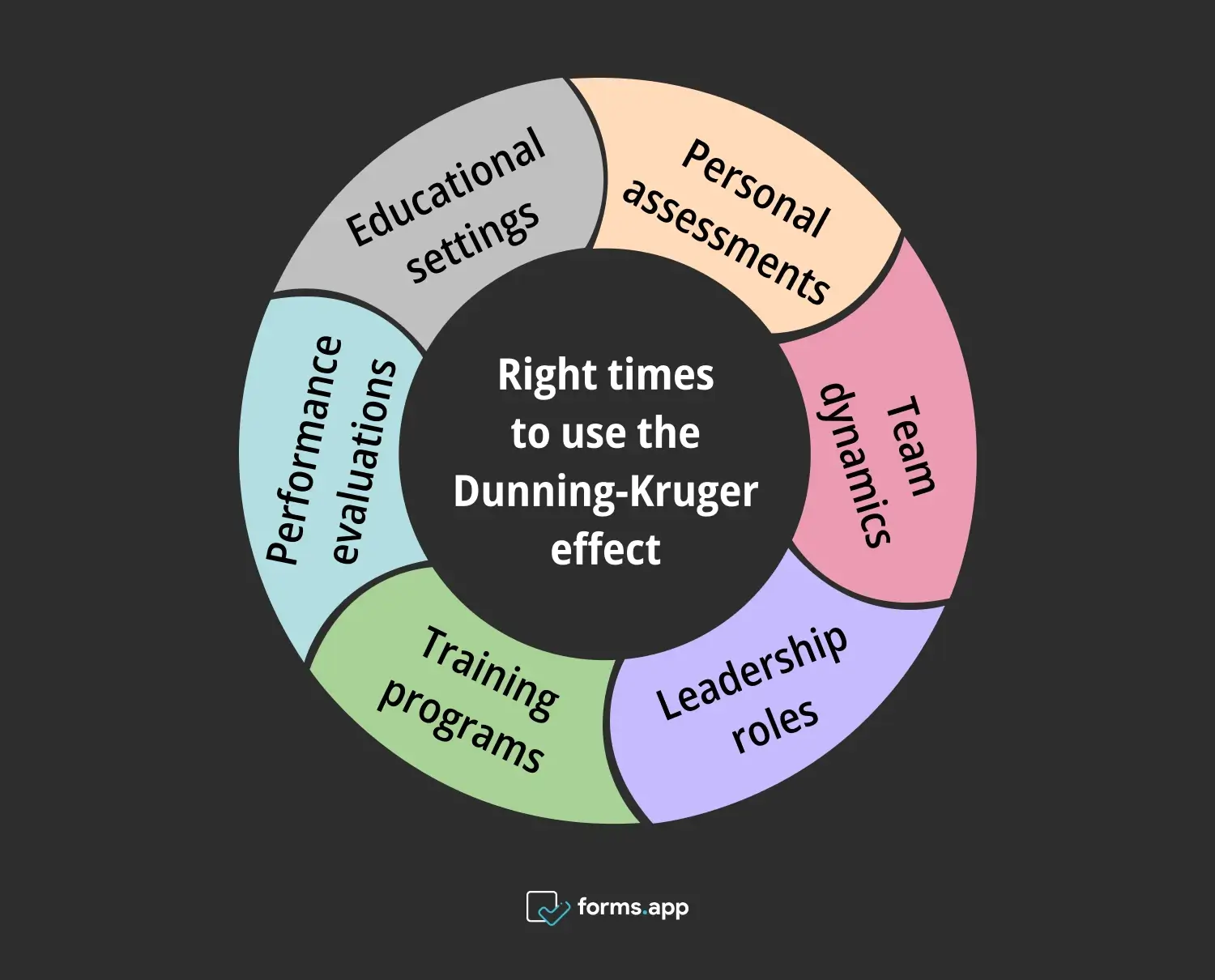
Correct times to use the Dunning-Kruger effect
⏰Personal assessments: Consider this effect when assessing your own skills or knowledge. Be mindful of moments where you feel excessively confident without concrete evidence or experience to support it. This could indicate a potential case of the Dunning-Kruger Effect.
⏰Team dynamics: In team settings, observe interactions where certain members consistently overestimate their abilities or dismiss critical feedback. These behaviors can disrupt collaboration and hinder collective performance.
⏰Leadership roles: Leaders should be aware of their decision-making processes and how overconfidence may influence them. Recognizing the Dunning-Kruger Effect helps leaders make more informed decisions and seek input from diverse perspectives.
⏰Training programs: When designing or participating in training programs, consider how participants perceive their own learning needs and capabilities. Addressing the Dunning-Kruger Effect ensures training is effective and meets genuine developmental needs.
⏰Performance evaluations: During performance reviews, look for signs of individuals who consistently rate themselves highly despite objective performance indicators suggesting otherwise. Addressing this bias ensures fair and accurate assessments.
⏰Educational settings: In educational contexts, educators should be mindful of students who exhibit overconfidence in their understanding or skills. Recognizing and addressing the Dunning-Kruger Effect helps educators provide targeted support and foster a growth mindset among students.
Frequently asked questions about the Dunning-Kruger Effect
Here, let's address common questions about the Dunning-Kruger Effect. Understanding some of the most frequently asked questions about the subject sheds light on how this phenomenon impacts self-assessment and decision-making processes. You will be able to better understand the effect and address it.
A classic example is an unskilled and unaware person taking on a leadership role in a project. They might be confident, but they will consistently fail to meet quality standards. Despite their belief in their abilities, their performance reflects a significant gap between perceived competence and actual skill level.
The Dunning-Kruger paradox describes the phenomenon where individuals with low competence tend to overestimate their abilities, while highly skilled individuals may underestimate theirs. This paradox arises from the assumption that tasks perceived as easy for oneself are equally manageable for others. This leads to misjudgments in self-assessment.
The Dunning-Kruger curve illustrates the relationship between competence and confidence. It shows that individuals with low ability tend to overestimate their competence, leading to high confidence.
As competence increases, confidence typically declines due to a more realistic understanding of one's limitations. The curve highlights how perceptions of skill and knowledge can diverge from actual performance, influencing behavior and decision-making.
Signs of the Dunning-Kruger effect include feeling excessively confident without objective evidence, dismissing critical feedback, and failing to acknowledge personal limitations or mistakes.
Recognizing these traits is crucial for seeking constructive feedback. It is also important to enhance self-awareness to bridge the gap between perceived and actual competence.
Conclusion
Understanding the Dunning-Kruger Effect is vital for personal and professional growth. Recognizing and addressing this cognitive bias helps in making better decisions, improving learning, and fostering a realistic self-assessment. Apply these insights to navigate your competence journey effectively. You can acknowledge and mitigate the Dunning-Kruger Effect.
In this article, we’ve explored the Dunning-Kruger Effect definition in detail. From understanding its components to practical applications, you now have a comprehensive guide. Now, you can enhance your decision-making, improve your skills, and foster a culture of continuous learning and growth.
- Let’s start with the basics: What is the Dunning-Kruger effect?
- What does trigger the Dunning-Kruger effect?
- How to address the Dunning-Kruger Effect
- Examples of the Dunning-Kruger effect
- Advantages and Disadvantages of Understanding the Dunning-Kruger Effect
- When to consider the Dunning-Kruger Effect
- Frequently asked questions about the Dunning-Kruger Effect
- Conclusion
forms.app, your free form builder
- Unlimited views
- Unlimited questions
- Unlimited notifications

